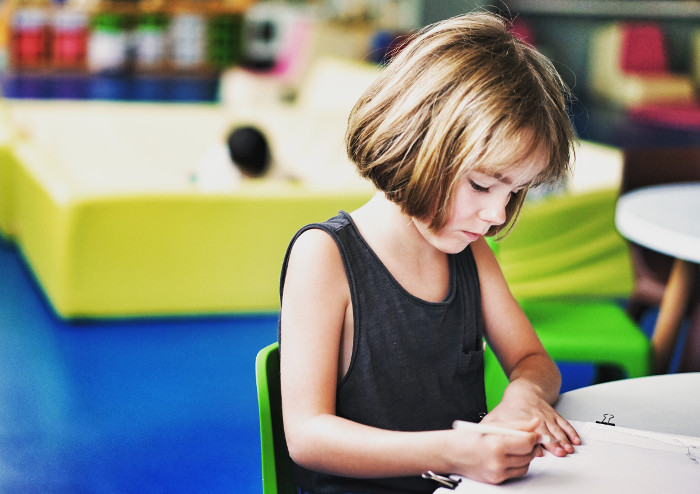The ability to communicate well is something that most of us would acknowledge is a key requirement in our adult life. Many may even have it as a key performance indicator or have a need to master the skill of communication as part of their job description. Some would have attended courses or workshops to enhance their communication skills, learning how to speak better, be understood better and how to engage those around them.

Communicating with our own children is also a skill, and just like any skill – it requires learning and practice. Some parents may feel anxious due to the assumption that communicating with their own kids should feel innate and natural.
But being able to reach out to any person, understand them and communicate in a style that builds a connection is not an innate ability – it is a skill. Our own children included. And developing a skill starts with awareness, followed by practice.
One of the key steps of enhancing our communication skills with our children is the ability to understand the personality styles of both ourselves and our children. One of the most universally used personality theories of today is the DISC Personality Theory, which has been created and used extensively since its introduction in 1928 by William Moulton Marston. This theory and its profiling tools provide a non-judgmental, objective assessment of an individual’s personality and have helped many in their own self-development.
What is DISC Personality?
The DISC personality method helps to provide a tool for all of us to understand ourselves. And mastery of ourselves is the key to being able to communicate and understand those around us.
Being aware of your own personality type and your children’s personality type helps to enhance your awareness of their uniqueness and enables you to replace judgment with acceptance – a very powerful frame of mind for positive relationships.
There are 4 main personality styles in the DISC theory. We have the D (Dominant) style, the I (Influential) style, S (Steady) style and C (Conscientious) style. To bring forth the idea of the 4 different styles, picture yourself in a crowded lift. Everyone is trying to get to work on time, and the lift buttons for most floors are lit up.

The D (Dominant) style person is the individual who keeps on glancing at his/her watch and presses the lift buttons multiple times to try to speed things up. This person wants to get to work as quickly as possible and get started on his list of things to do.
The I (Influential) style person, is the one who loves people, who greet everyone with a cheery hello even though it is really early. They enjoy talking and chatting to those around them and are highly enthusiastic and expressive in their behaviour.
The S (Steady) style person is the one who tends to be quietly observant, perhaps talking quietly to his/her good friend, and is concerned with holding the door for others. This is the person who says “Hey, come on in, don’t worry, there is enough room”.
And the C (Conscientious) style person is the quieter one who looks at the weight limit of the lift as more people enter the lift and checks the last date of inspection conducted by the authorities. This person is concerned with processes and details.
This is a simplified analogy of the theory. We are definitely more complex than the 4 styles above, with many more nuances of each personality type. Most people are not limited to just one style, in fact, we are mostly blends of a few personality styles.
But the key idea is that all of us have a tendency to behave in a certain way due to our personality styles and these personality styles influence us in many ways including our relationship and communication styles with our children.
D (Dominant) style parents
D style parents tend to be energetic, results-oriented, and usually surround themselves with a high level of activity. They are go-getters and enjoy problem-solving. D style parents tend to communicate directly, getting straight to the point.
They tend to focus on the end result, and not so much on emotions, or the process. D style parents view themselves as role models and strive to be a figure of authority at home. Emotional outbursts, dramatic explanations, slower-paced, long drawn out responses are usually not the D style parents’ cup of tea.
Long discussions on the why and how may not bring out the best in D style parents, and they may respond to negative situations using strong tones and body language.
Tips with D style children
D style children are motivated by power and authority, and when interacting with a D style parent, there may be a battle for authority. In this relationship, it is important for the parent to remember that the child (who is similar in personality to themselves) places a high value on the ability to have control and be able to make decisions.
Choose to not present every problem as a battle, instead, remember that the child needs to feel in control, the way you yourself do. Present choices within an acceptable range – “the blue shirt or the green shirt”, “bagels or sandwiches”. Establishing authority is important but always keep in mind that choices mean a lot to the D style child.

Tips with I, S and C children
With I, S, and C style children, D style parents need to find patience and accept that the children need to do things or communicate at a different pace. Acceptance is very powerful – if you are able to nurture acceptance, it becomes easier to place yourself into their shoes, view the situation through their eyes and see how they like to communicate.
For example, the C style children are not telling you a long, detailed story about their day at school just for you to listen to the ending line – they needed you to hear the entire story as it’s their way of communication. The details are important to them.
Moderating tone and body language are also important steps and keep in mind also that S and C style children may not always be expressive, and may display a quiet response and internalise their emotions. Not speaking up is not always an indication of non-dissent, something a D style parent may need to keep in mind as it is not the natural style of a D style parent.
I (Influential) style parents
I style parents love to talk and are usually exuberant and enthusiastic. They get energised by talking and interacting with people. They tend to be fun-loving and enjoy doing new things, usually surrounded by friends and family. I style parents are usually very positive in their outlook, and can always find the silver lining in most situations.
They generally dislike saying no and can sometimes be carried away by new ideas. They prefer brainstorming on exciting new ideas rather than following through on the process and completion. Time management and attention to detail may also be less regarded.

Tips with D style Children
When an I style parent talks to a D style child, the child may seem to tune out and lose focus. This may agitate the parent as it may be perceived as being intentionally rude. Try rephrasing your instructions to the way a D style child talks – get to the bottom line first.
Highlight the objective or the benefits, before moving on to the rest of the instructions – as succinctly as possible. Adjust the method of communication to a D style child, by keeping in mind that the D style child is result-oriented.
Tips with S and C Style Children
The S and C Style children may find the exuberance of the I style parent overwhelming as they tend to be outwardly quieter, and are more process-focused. Consider making adjustments to the communication setting – perhaps a quieter setting, including one-to-one type outing or time together, in order to open the communication channel.
Understanding that the S and C style children communicate in a quieter manner as compared to the parent is important. Not being vocal or loud does not mean that they do not enjoy communicating. Many S and C style children are actually very verbal in nature – they just prefer not to do so with a large group of people.
S (Steady) style parent
The S style parent is someone who tends to prioritise their family and is usually kind, selfless and calm. The S style parent likes the environment to be steady and predictable. They dislike change and prefer to avoid conflict.
In a situation where the S style parent disagrees with something, their emotions tend to be internalised and when stressed, can potentially exhibit passive-aggressive behaviours, and can be viewed as being stubborn.
S style parents may sacrifice their own needs to the point of tipping over to neglecting their own wants and needs. Remember that a happy child needs a happy parent.

Tips with D style children
Despite the parent’s discomfort with conflict and authority, it is important that authority is established at home, especially with the D style child. Boundaries and authority may not be an area of comfort for the parent, but do remember that the D style child respects people who hold their ground.
Again, replacing judgment with acceptance is a very powerful tool for building relationships – see the situation through the lens of the other personality.
Tips with I style children
I style children love fun and enjoy new things. What is viewed by the I style child to be exciting, may be viewed by the S style parent to be “a disruptive change”. The S Style parent is usually able to accept the change to a point (as they prioritize avoiding conflict) but this acceptance may build up as stress.
Work on understanding that the “disruptive change” is usually not done in an effort to annoy the parent – it is usually due to their personality tendencies that life should be fun and exciting – and change is exciting to them.
C (Conscientious) style parent
This is the parent who enjoys planning and loves details. They tend to be highly logical individuals and are rational and process-oriented. They like reading manuals, they follow processes one step at a time, and they like things at home to run in a certain way. Everything should be done right the first time.
Details are important, and they tend to notice the finer points or the lack of it. The C style parent may not take disruption to processes well and may feel stressed when there is change. They may also be perceived as being unemotional and picky.
Tips with I Style Children
The C style parent may find that I style children with their high enthusiasm and love for spontaneity difficult to handle. The C style parent also tends to zero in on details, which the I style child may completely miss. The microfocus of the parent versus the macro focus of the child may cause conflict if both do not understand one another.
It may help to reframe oneself to remember that the child sees life using a different lens. He/she sees things differently. Try to focus on riding along with the positive energy that the child brings, provide them with some space to express their energy.
Choose your battles by focusing on key important processes to you and work on those with your child. Let them understand the reason the processes are important and not just focus on the steps and process.
Tips with S and C Style Children
C style parents will find C and S style children to be similar to themselves – a feeling of comradeship. Steady, quiet, respect for processes and low conflict. But the comradeship does not necessarily equate to good communication.
In fact, be wary that all of you tend to internalise emotions and keep many of your thoughts under wraps. Work on opening lines of communication, provide ample opportunities to share your own thoughts and your feelings – and let them reciprocate.
Understanding yourself first
A healthy relationship with our own children is not an inborn, natural trait, but just like any relationship, it requires work, nurturing and practice. We meet clients who want to improve the relationship, but do not realise that the mindset has to start from asking themselves a very fundamental question, which is Who Am I?
Self-mastery of your own personality is the starting point for any relationship. Focusing strictly on the child is only half the relationship. But every parent is different, every child is different and you need to know both sides of the relationship in order to strengthen it.
Awareness of your own personality type vis a vis your children’s personality type can definitely make it easier to work towards a healthy relationship – by removing judgment and replacing it with awareness and acceptance.

Most importantly, the mutual acknowledgement that both you and your child are unique individuals with a unique personality type and innate tendencies is a great first step towards building a relationship.
You will be surprised at how positively children respond to your own acknowledgement that you yourself have natural tendencies and behaviours that sometimes make you feel a little uncomfortable in certain situations and more comfortable in others.
Children learn by copying. Let them see that you have your own weaknesses, your own habits and how you are working on augmenting your strengths while adjusting your behaviour to counter uncomfortable situations. And then watch them do the same and grow with you.
This article is contributed by Hwang Siew Ling, the founder of Discovering Potential. She is an entrepreneur, a Certified Advanced Behavioural and Career Consultant in DISC Personality Assessments, and is also Myers-Briggs Type Indicator (MBTI) certified, with 20 years of industry experience in the corporate and entrepreneur world.
* * * * *
Stay in touch! Subscribe to our Telegram here for all our latest updates.
Want to be heard 👂 and seen 👀 by over 100,000 parents in Singapore? We can help! Leave your contact here and we’ll be in touch.


























































